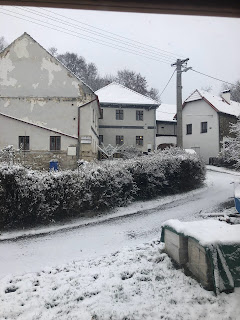I am sometimes asked how I found our Czech house. The answer is Hannah's carpenter - Frantisek. She told him I was looking and he took it upon himself to find the right house for me. When I said how it called to my soul, he did one of his mysterious smiles and said "Vim" (I know). That comment pretty much summed him up. He was a man of very few words, seldom more than two left his lips at any one time. But he had a spirituality that was beyond words. The first time I met Frantisek was when he was playing Jesus in the Horice na Sumava Passion play - a part he was made for. Hannah and I joked that he was so into method acting that he never came out of character. To my husband and me Frantisek is always known as "Frantisek Jesus."
Frantisek was an artist rather than a carpenter. I remember how he stroked the curve of a desk he made for Hannah out of one plank of wood. Nothing Frantisek made was ever quite straight, which was a problem if you wanted him to make a door, but not if you wanted something beautiful. How I wanted him to make me some furniture. But first the house needed repairing, and after a disaster in which he removed my windows to repair without numbering them, I was disinclined to offer him precision work.
One day he arrived excited that he could source some wood cheaply for Hannah and me. We both ordered a load of rough hewn planks - Hannah chose oak and I elm. Mine were piled in the barn to wait the time when they could be transformed into furniture. Very soon I discovered that mine had woodworm, something elm is prone too. Woodworm didn't seem to worry Frantisek over much. On a visit to his house and workshop in Horice, I found my feet sinking into the floorboards they were so wormy. When I finally left my Czech home, the elm planks remained unused and were only fit for firewood. I never did get the chance to own one of Frantisek's quirky bookcases.
Over the years Frantisek would occasionally turn up for a wordless visit. But then his visits stopped. When I asked my neighbour, a mutual friend, she told me that Frantisek had been working in Germany (something many local craftsmen do) and that one day coming home over the Sumava mountains and probably tired after a long week of work, he mistook a tight bend and drove into a tree. His son who was with him was thrown clear, but Frantisek was killed.
I shall always be grateful for that silent, strange and wonderful man. When I left my Czech home I left a carving, the only thing Frantisek made for me, a self portrait of Jesus. It was too heavy to take on the plane and besides I very much felt that it should stay there.




















